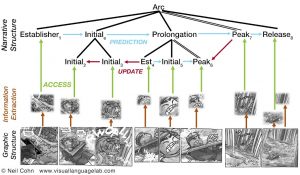New paper: Visual narratives and the Mind
My latest paper, “Visual narratives and the mind: Comprehension, cognition, and learning” is published in the collection Psychology of Learning and Motivation. This paper integrates a few threads of research that I’ve been working on lately.
The first section presents the cognitive processes that go into understanding a sequence of images, integrating two of the most recent psychological models on the issue. These include my own neurocognitive model of sequential image understanding that integrates both semantic and narrative structures, and an approach from some of my colleagues emphasizing aspects of scene perception and event cognition.
The second section then asks, given these cognitive processes related to visual narrative understanding, how much of them are specialized for that specifically? Are these general mechanisms that also apply to other aspects of cognition, like language? I argue for two levels of this: more specialized processing mostly has to do with the modalities themselves: how you engage written text might be different from how you engage pictures. However, the “back end” processes—how you compute meaning and order them into sequences—likely is more connected across other domains.
Finally, I then examine the relation between these cognitive processes and how children learn to understand a sequence of images. A wide literature points to children only starting to understand the sequential aspects of visual narratives between ages 4 and 6. So, I discuss the stages in children’s development of understanding sequential images, and link this to the cognitive processes discussed in the first section.
You can find a direct preprint pdf version of the paper here, as well as on my downloadable papers page. Here’s the abstract:
The way we understand a narrative sequence of images may seem effortless, given the prevalence of comics and picture stories across contemporary society. Yet, visual narrative comprehension involves greater complexity than is often acknowledged, as suggested by an emerging field of psychological research. This work has contributed to a growing understanding of how visual narratives are processed, how such mechanisms overlap with those of other expressive modalities like language, and how such comprehension involves a developmental trajectory that requires exposure to visual narrative systems. Altogether, such work reinforces visual narratives as a basic human expressive capacity carrying great potential for exploring fundamental questions about the mind.
Cohn, Neil. 2019. Visual narratives and the mind: Comprehension, cognition, and learning. In Federmeier, Kara D. and Diane M. Beck (Eds). Psychology of Learning and Motivation: Knowledge and Vision. Vol. 70. (pp. 97-128). London: Academic Press

Comments